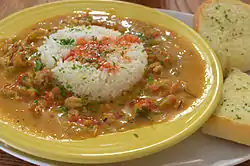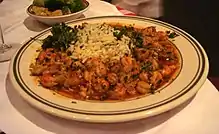Étouffée
Étouffée or etouffee (French: [e.tu.fe], English: /ˌeɪtuːˈfeɪ/ AY-too-FAY) is a dish found in both Cajun and Creole cuisine typically served with shellfish over rice. The dish employs a technique known as smothering, a popular method of cooking in the Cajun and Creole areas of southwest Louisiana. Étouffée is most popular in New Orleans and in the Acadiana area of the southernmost half of Louisiana as well as the coastal counties of Mississippi, Alabama, northern Florida, and eastern Texas.
 Crawfish étouffée, served at a restaurant in New Orleans | |
| Type | Stew |
|---|---|
| Course | Main |
| Place of origin | United States |
| Region or state | Louisiana |
| Main ingredients | Shellfish, rice |
Etymology
In French, the word "étouffée" (borrowed into English as "stuffed" or "stifled") literally means "smothered" or "suffocated", from the verb "étouffer".[1]
Description

Étouffée is a dish of shellfish, simmered in a sauce made from a light or blond roux, served over rice. It is most commonly made with shellfish, such as crab or shrimp. The most popular version of the dish is made with crawfish. Depending on who is making it and where it is being made it is flavored with either Creole or Cajun seasonings. Although Creole and Cajun cuisines are distinct, there are many similarities.[2]
In the case of the Creole version of crawfish étouffée, it is made with a blond or brown roux and sometimes tomatoes are added.[3][4] A blond roux is one that is cooked, stirring constantly, for approximately 5 minutes to remove the "raw" flavor of the flour and to add a slightly "nutty" flavor, while a brown roux is cooked longer (30 to 35 minutes) in order to deepen the color and flavor.[5]
History
Around the 1950s, crawfish étouffée was introduced to restaurant goers in Breaux Bridge, Louisiana; however, the dish may have been invented as early as the late 1920s, according to some sources.[6][7] Originally, crawfish étouffée was a popular dish amongst Cajuns in the bayous and backwaters of Louisiana. Around 1983, a waiter at the popular Bourbon Street restaurant Galatoire's brought the dish to his boss to try. At the time, most New Orleans restaurants served French Creole cuisine, but this Cajun dish was a hit.[8]
See also
References
- Louisianaliving.com Archived October 17, 2011, at the Wayback Machine
- Louisianafishfry.com Archived April 21, 2012, at the Wayback Machine
- "Crawfish Étouffée". neworleansonline.com. Retrieved 3 July 2015.
- Wuerthner, Terri. "Creole and Cajun Cookery Different Yet Similar". Retrieved Jan 4, 2014.
- "All About Roux". Allrecipes.com.
- "City Government of Breaux Bridge Louisiana, History of Breaux Bridge". Archived from the original on 2014-01-04. Retrieved Jan 4, 2014.
- "Saveur Magazine, Crawfish Étouffée". Bonnier Travel & Epicurean Group. Jan 17, 2007. Retrieved Jan 4, 2014.
- Cason, Colleen (February 13, 2009). "From Swamp to Swank: Flavor Elevates Crawfish Étouffée", Ventura County Star. Archived from the original on October 21, 2014. Retrieved December 16, 2015.
| Wikimedia Commons has media related to Étouffée. |
